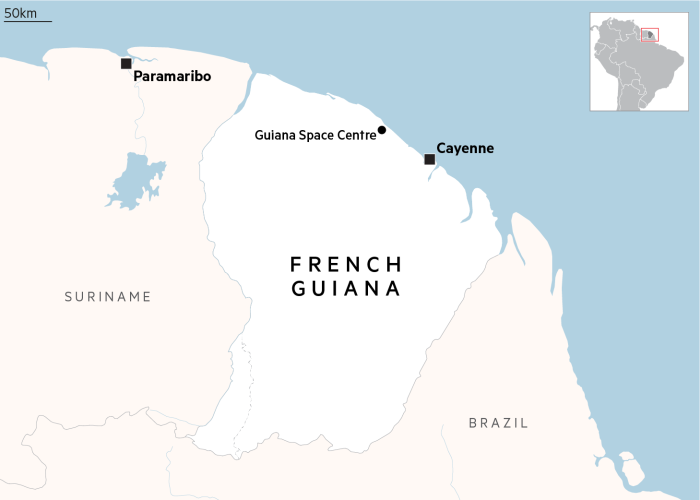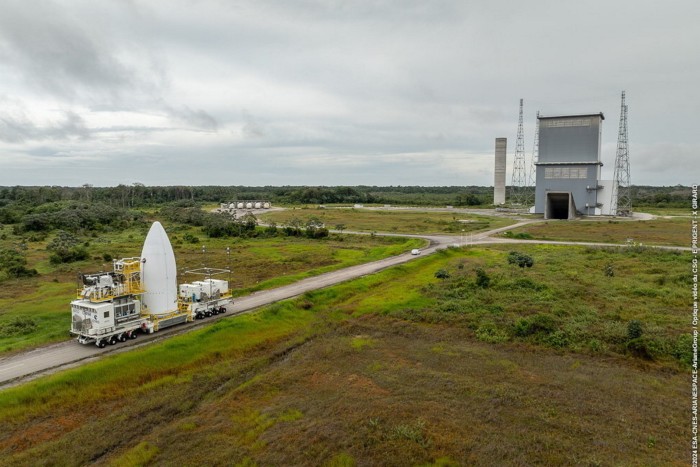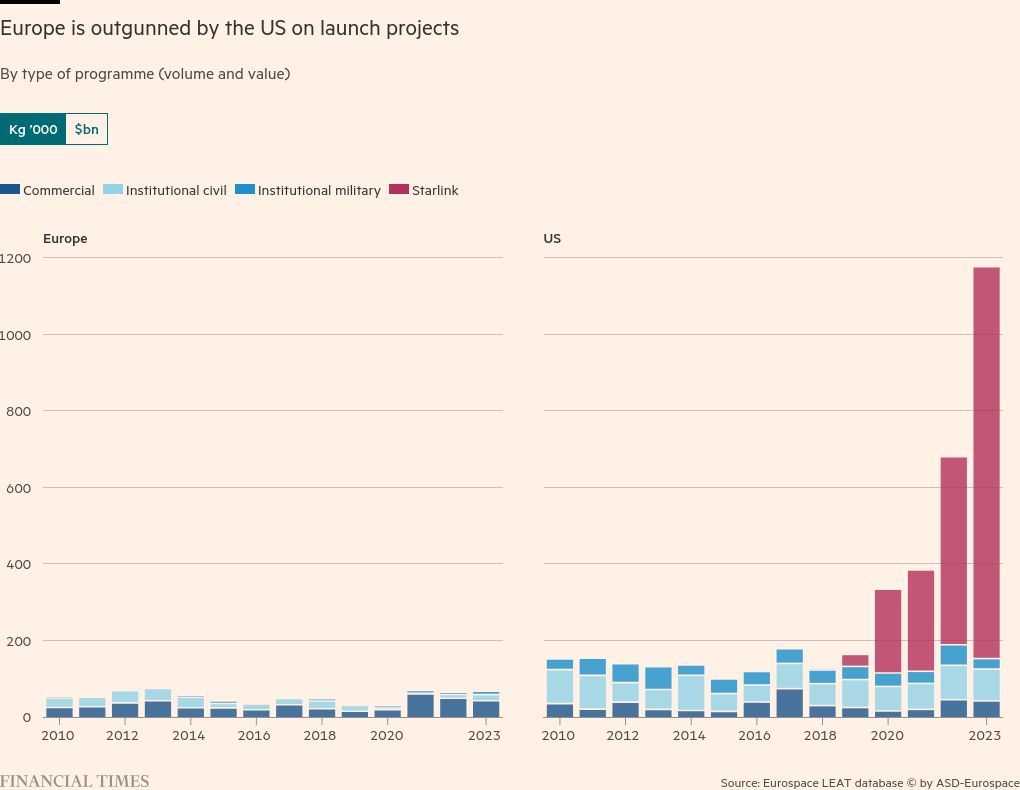On July 9, Anne-Sophie Chassagnou will assess whether the skies are clear enough for Europe to launch its first new rocket in nearly 30 years.
At the age of just 26, the chief meteorologist for the first Ariane 6 flight is having a huge impact on the continent’s space ambitions. Last year, just minutes before ignition, a meteorologist at the French space agency CNES called off the first attempt to launch Europe’s €1.6 billion mission to explore Jupiter’s icy moons.
“My body was shaking when I had to press the red button,” she said from Europe’s spaceport in French Guiana, between Brazil and Suriname, but if conditions aren’t right for Ariane 6, she won’t hesitate to do it again. “I don’t want to, but if I have to, I will,” she said.
This time, much more is at stake than a deep space mission. The first flight of the Ariane 6 heavy-lift rocket will test whether Europe can restore credibility in the commercial launch market once dominated by Ariane 5 and now Elon Musk’s SpaceX.
Europe is also counting on Ariane 6 to restore its independent access to space – an increasingly contested area where global superpowers are fighting for economic and strategic supremacy. For the past year, the bloc has had to rely on SpaceX to launch some of its most sensitive satellites.
It’s an uncomfortable position. In the 1970s, the US tried to prevent some European satellites from competing commercially in exchange for providing launch services. “The Ariane program was launched by not having commercial access to space,” said Eric Dalbiès, chairman of ArianeGroup, the French joint venture that builds Europe’s Ariane heavy rockets. “It revived the need for Europe to have a sovereign approach.”
Now Europe is once again without its own launch capacity after Ariane 5 was retired last July. Technological challenges, pandemic lockdowns and a lack of skills have caused a costly four-year delay for Ariane 6. Cooperation with Russia ended after its invasion of Ukraine, and problems with Italy’s new medium-sized Vega-C launcher have kept the rocket grounded from 2022.
Josef Aschbacher, head of the European Space Agency, described the situation as a “crisis” for Europe. The EU’s new space strategy for security and defense has made restoring autonomous access to space a priority.
At the Guiana Space Center, located near the coastal city of Kourou, teams from ESA, CNES and ArianeGroup have been working hard to achieve this goal.
In April, the rocket core was transferred to the launch pad and two boosters carrying 140 tons of solid fuel were attached. On June 20, Ariane 6 was fueled and launched in its final test. Sixteen satellites and experiments were loaded into the rocket.
Nearly 50 percent of rockets fail on their first flight, according to Aschbacher, but officials at Kourou hope repeated tests and trials have mitigated the risks. The emphasis is on “getting it right the first time,” says Lucia Linares, ESA’s head of strategy.

Even if the first flight fails, Europe’s strategic needs will keep the program alive. Less certain is whether the missile can compete in a market that has changed radically since Europe decided to build a conventional launcher in 2014.
SpaceX’s reusable Falcon 9 has reduced prices, becoming the clear leader in cheap and reliable launches. This week, the EU weather satellite operator decided to launch its next spacecraft on SpaceX rather than wait for Ariane 6. SpaceX expects Starship, the world’s most powerful rocket, which completed its fourth test flight this month, to also be reusable – unlike Ariane 6.
Europe’s decision not to invest in a reusable missile is widely seen as a mistake. According to former ESA chief Jan Wörner, Germany was reluctant to pay for the new rocket program. “The German idea was to continue with the Ariane 5 but have a new upper stage. It was a cheap solution,” he said.
But France, which has long dominated Europe’s launch vehicle industry, wanted to preserve shuttle jobs and skills with the new program.

A compromise was reached. ArianeGroup, a merger of Franco-German rocket companies Airbus and Safran, has promised to design an expendable launcher that will be at least 50 percent cheaper to operate than Ariane 5, fly in five years and require no subsidy, Wörner said. . The program failed on all these counts.
Last fall, ESA member states agreed to put in an additional €1 billion, on top of an estimated €4 billion in development, to help Ariane 6 compete with SpaceX.
Some experts defend Europe’s decision to reject reusability in favor of an expendable launch vehicle with a highly flexible upper stage that can launch satellites into multiple orbits in a single mission. A reusable rocket, they said, would require significant sustained demand, which was not available.
“It was the right decision,” Linares said. “It’s true that if you reuse the first stage . . . you usually reduce the cost. But it depends on how many times you can launch.”
Still, even with a conventional rocket, demand matters, and Ariane 6 is entering a tougher commercial market than its predecessor.
According to Novaspace analysts, the US will launch roughly three times as many satellites as Europe for governments, universities and other institutions and nearly ten times as many commercial spacecraft over the next decade. The Pentagon, NASA and Musk’s own Starlink satellite broadband service are likely to turn to SpaceX before Ariane.

Meanwhile, a slew of launch vehicle startups around the world are eyeing the booming market for low-Earth orbit satellite services.
“Ariane previously launched two non-institutional satellites for every institutional satellite. But today new launch vehicles are capturing this demand,” said Pierre Lionnet, head of research at trade organization ASD-Eurospace.
Novaspace estimates that approximately 2,800 satellites will be launched annually by 2033. Homegrown launch vehicles cover most of that business, but Linares believes plenty will still be open to competition — and Ariane’s flexibility will be an advantage.
Ariane 6 is already booked for 30 launches, including 18 for the upcoming broadband constellation of the Amazon Kuiper project. Customers want diverse launch providers outside of SpaceX, Linares said.
But even those involved in the European program concede that the system that produced Ariane 6 — which awards supply contracts based on nationality rather than competitiveness — will have to change. This year, ESA launched a competition to develop small commercial launchers from which it will purchase services.
The move was an “electric shock” to the corporate and political complacency that was preventing Ariane 6, one insider said.
Yet the high cost of a heavy-lift rocket means that Europe cannot avoid cooperation and compromise, which may further hamper competitiveness.
“I am not convinced that in Europe we will be able to offer launch services at prices as low as SpaceX,” said Carine Leveau, head of space transport systems at CNES. “But we can be more competitive than today and more than we will be with Ariane 6.”
For now, however, the priority is to ensure Europe’s access to space. “It is very important that this inaugural flight is a success,” she added. “It will calm everyone down.
Illustrated by Ian Bott